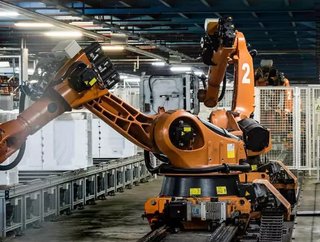I can’t do that, Dave: working in harmony with AI

From Fritz Lang’s tragic heroine, Maria, to the mutinous HAL 9000 and the Johnny Cab in Total Recall, we’ve been thinking about how robots would fit into our society since the 6th Century BC, when Homer and his contemporaries wrote of clay statues come to life in Hephaestus’ divine forge. Unfortunately, our robot future has yet to materialise. However, due to advances in deep learning and artificial intelligence (AI), some version of a society in which humankind coexists with our very own ‘clay statues come to life’ is closer than we may realise.
When AI started being used to improve robotic process automation and otherwise take over tasks from human labourers, the alarm bells were sounded frantically. In 2013, the University of Oxford predicted that approximately 50% of jobs in the United States and about 33% in the UK would be put at high risk of automation in the following years. However, this figure has since been revised as we’ve gained a better understanding of the strengths and limitations of AI-powered automation. In April the economic organisation OECD said the figures are more likely to be just 10% in the US, and 12% in the UK. According to James Dening, VP and Digital Worker Evangelist at Automation Anywhere, “In our work with Goldsmith’s University we found automation will likely replace 58% of work activities and 30% of tasks, but only 5% of jobs in their entirety, since its true purpose is to supplement human activity.”
Harvey Lewis runs an emergent technology team at the global accounting firm EY, keeping a watchful eye on developments in academia, the startup scene and in large, established corporations. One of his principle focuses is the evolving role of AI in the modern workforce. He says he doesn’t want to burst my bubble, but that I shouldn’t believe all the hype about HAL 9000 coming to take away my jobs. “A general AI that ‘thinks’ and behaves like a human is almost pure fantasy if I'm completely honest,” he said over a cup of coffee at Big Data LDN in November. I sat down with him in the middle of a noisy conference hall packed with data scientists to find out about the evolving relationship between human workers and the increasingly sophistical AI labour force we’ve been promised.
“The thing about neural networks in particular is that they're very narrow in their scope, and as a consequence they're very brittle. If you change the situation even slightly they just fall apart and they can't produce an answer,” Lewis explains. “There are things that people can do which, to be honest, I don't think machines will ever be able to do: the way we are able to reason, to make inferences, the way that we're able to hold multiple representations of things in our heads and apply the appropriate ones at different times.”
SEE ALSO:
In an interview with the Guardian in 2014, Elon Musk declared - with his characteristic flair for the dramatic - “I think we should be very careful about artificial intelligence. If I had to guess at what our biggest existential threat is, it’s probably that.” Even keeping in mind the changing predictions concerning automation’s threat to the job market since then, it’s a bold claim. Lewis smiles wryly before answering: “I think that the existential risk to our society is believing that AI is perfect, and then leaving it to take on really very important jobs which it then does a bad job of. There are some problems humans find really easy to solve that machines find very difficult - and almost no amount of programming seems to fix that problem.”
If there are some things that AI can accomplish far better than any human, and some things that leave it a gibbering wreck, a collaborative relationship could prove beneficial for all. Robots have already been automating physical tasks, particularly in the manufacturing industry, for years already. Lewis sees this translating itself into increasingly complex digital tasks over the coming years that will allow humans “working alongside to fill in the gaps” in ways that play to their strengths.
Guy Kirkwood, the chief evangelist at UiPath even believes that a world in which digital workers would lead to happier, more engaged human colleagues. Citing a Gallup poll in which 87% of employees worldwide reported not being engaged in their roles, something that means disengaged employees cost the UK £52-70bn per year in lost productivity, Kirkwood is confident that “not only can RPA help drive productivity, but it can also help create a happier workforce. The average person currently works two and a half extra weeks a year due to the UK’s ‘long-hours culture’ – and with burnout rife in today’s society, automation is key to helping address the work/life balance. In a world where everyone is supported by automation (where there is a robot for every person) employees will feel less stressed, and ultimately happier and more productive.” At Automation Anywhere, Dening has experienced similar results. “We found that businesses using cognitive automation bots to support human workers see a range of performance, productivity and financial benefits,” he said. “Intriguingly, these augmented businesses were also consistently reporting an uptick in employee satisfaction.”
This added productivity, and the addition of intelligent computing to incredibly complex and high-pressure tasks is why McLaren has embraced Automation Anywhere as part of a multi-year deal to integrate artificially intelligent bots into the team’s race operations. “McLaren Racing operates in a competitive environment dominated by fine margins, where seconds can have a major impact,” commented Riadh Dridi, Chief Marketing Officer at Automation Anywhere in a press release. Dening added that “McLaren will be deploying Automation Anywhere’s intelligent digital workers to improve communication and decision making between the race teams and the McLaren HQ in Woking. As part of this partnership, Automation Anywhere will be helping McLaren make faster decisions across the team’s race operations as they chase marginal gains on the track. Digital workers will work side-by-side with the race operations team to complete repetitive and manual tasks, so the ultimate goal is to help McLaren create efficiencies, reduce errors and speed up decision making.”
There are problems facing the introduction of AI, though. As Lewis put it, there are already more jobs that require a knowledge of AI than there are people qualified to fill them. “Right now, the approach is one of firefighting: small teams of experts are called in to deal with bigger issues,” he explains. It’s my hope, however, that through education, we can equip the next generation with the skills, not necessarily to build technologies, but with the kind of computational thinking, the level of detail they need to properly understand what's going on, how the technology works, and more importantly, the way in which problems are solved.” According to the World Economic Forum, 65% of children now entering primary school will hold jobs that currently don’t exist. AI may not be coming to take our jobs away from us, but increasingly widespread integration of the technology into the workforce is going to change the nature of those jobs, forever.
- OpenText AI: Empowering Businesses in Information ManagementDigital Transformation
- Microsoft in Japan: $2.9bn Investment to Boost AI & CloudCloud & Cybersecurity
- Google Cloud Next 2024: Pushing the Next Frontier of AIAI & Machine Learning
- Coforge: Arming Financial Firms with the Tools to InnovateDigital Transformation






